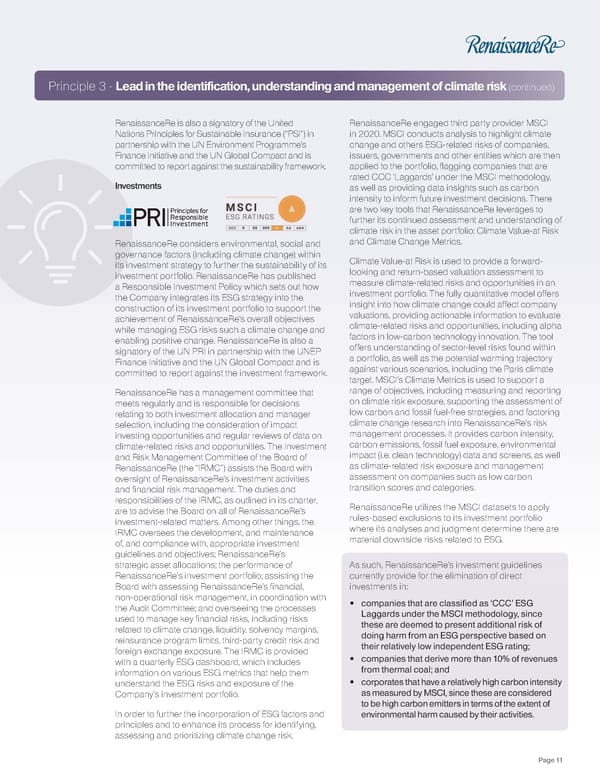Principle 3 - Lead in the identification, understanding and management of climate risk (continued) RenaissanceRe is also a signatory of the United RenaissanceRe engaged third party provider MSCI Nations Principles for Sustainable Insurance (“PSI”) in in 2020. MSCI conducts analysis to highlight climate partnership with the UN Environment Programme’s change and others ESG-related risks of companies, Finance Initiative and the UN Global Compact and is issuers, governments and other entities which are then committed to report against the sustainability framework. applied to the portfolio, flagging companies that are rated CCC ‘Laggards’ under the MSCI methodology, Investments as well as providing data insights such as carbon intensity to inform future investment decisions. There are two key tools that RenaissanceRe leverages to further its continued assessment and understanding of climate risk in the asset portfolio: Climate Value-at Risk RenaissanceRe considers environmental, social and and Climate Change Metrics. governance factors (including climate change) within Climate Value-at Risk is used to provide a forward- its investment strategy to further the sustainability of its looking and return-based valuation assessment to investment portfolio. RenaissanceRe has published measure climate-related risks and opportunities in an a Responsible Investment Policy which sets out how investment portfolio. The fully quantitative model offers the Company integrates its ESG strategy into the insight into how climate change could affect company construction of its investment portfolio to support the valuations, providing actionable information to evaluate achievement of RenaissanceRe’s overall objectives climate-related risks and opportunities, including alpha while managing ESG risks such a climate change and factors in low-carbon technology innovation. The tool enabling positive change. RenaissanceRe is also a offers understanding of sector-level risks found within signatory of the UN PRI in partnership with the UNEP a portfolio, as well as the potential warming trajectory Finance Initiative and the UN Global Compact and is against various scenarios, including the Paris climate committed to report against the investment framework. target. MSCI’s Climate Metrics is used to support a RenaissanceRe has a management committee that range of objectives, including measuring and reporting meets regularly and is responsible for decisions on climate risk exposure, supporting the assessment of relating to both investment allocation and manager low carbon and fossil fuel-free strategies, and factoring selection, including the consideration of impact climate change research into RenaissanceRe’s risk investing opportunities and regular reviews of data on management processes. It provides carbon intensity, climate-related risks and opportunities. The Investment carbon emissions, fossil fuel exposure, environmental and Risk Management Committee of the Board of impact (i.e. clean technology) data and screens, as well RenaissanceRe (the “IRMC”) assists the Board with as climate-related risk exposure and management oversight of RenaissanceRe’s investment activities assessment on companies such as low carbon and financial risk management. The duties and transition scores and categories. responsibilities of the IRMC, as outlined in its charter, RenaissanceRe utilizes the MSCI datasets to apply are to advise the Board on all of RenaissanceRe’s rules-based exclusions to its investment portfolio investment-related matters. Among other things, the where its analyses and judgment determine there are IRMC oversees the development, and maintenance material downside risks related to ESG. of, and compliance with, appropriate investment guidelines and objectives; RenaissanceRe’s strategic asset allocations; the performance of As such, RenaissanceRe’s investment guidelines RenaissanceRe’s investment portfolio; assisting the currently provide for the elimination of direct Board with assessing RenaissanceRe’s financial, investments in: non-operational risk management, in coordination with • companies that are classified as ‘CCC’ ESG the Audit Committee; and overseeing the processes Laggards under the MSCI methodology, since used to manage key financial risks, including risks these are deemed to present additional risk of related to climate change, liquidity, solvency margins, doing harm from an ESG perspective based on reinsurance program limits, third-party credit risk and their relatively low independent ESG rating; foreign exchange exposure. The IRMC is provided with a quarterly ESG dashboard, which includes • companies that derive more than 10% of revenues information on various ESG metrics that help them from thermal coal; and understand the ESG risks and exposure of the • corporates that have a relatively high carbon intensity Company’s investment portfolio. as measured by MSCI, since these are considered to be high carbon emitters in terms of the extent of In order to further the incorporation of ESG factors and environmental harm caused by their activities. principles and to enhance its process for identifying, assessing and prioritizing climate change risk, Page 11
 2022 ClimateWise Report Page 12 Page 14
2022 ClimateWise Report Page 12 Page 14